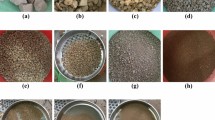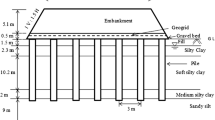Abstract
A ground modification technique with rigid columns and ground beams for supporting an embankment over multilayered soft soils is introduced and investigated. A fully coupled three-dimensional finite element analysis was performed to examine the effect of beam inclusion into a piled embankment system. After validating the numerical model against field measurements, the time-dependent behavior of the innovative support system was further investigated with an isolated pile-supported embankment used as a control. A three-dimensional soil arch model is proposed for piles arranged in a square pattern with beam reinforcement. The kinematics of soil arching under staged construction of embankments and subsoil consolidation illustrates that the height of the outer boundary is generally lower with ground beams, suggesting that soil arching can be more easily mobilized in this configuration than in individual pile-supported embankments. When the tops of adjacent piles are connected with ground beams, load transfer to piles becomes more efficient, preventing the arch failure at the crown and punching shear failure at pile heads. Wider pile spacing leads to an increase in size and critical height of soil arches, while the fill over tops of beams may undergo larger plastic deformation. The inclusion of beams substantially reduces post-construction settlement and accelerates the dissipation of excess pore water pressure within soft soils. Performance of piled beam-supported embankment (PBSE) was ultimately evaluated by using two efficient comparison models. Under the same area replacement ratio conditions, PBSE significantly outperforms a geosynthetic-reinforced piled embankment with pile caps. Although PBSE is little less efficient than an embankment supported by slab–pile structure, the construction cost is substantially higher for the latter. A wider application of PBSE to high-speed rails is promising but it needs to be assessed against more field evidence.
























Similar content being viewed by others
Data availability statements
The datasets generated during and/or analyzed during the current study are available from the corresponding author on reasonable request.
References
Bhasi A, Rajagopal K (2015) Geosynthetic-reinforced piled embankments: comparison of numerical and analytical methods. Int J Geomech 15:04014074. https://doi.org/10.1061/(ASCE)GM.1943-5622.0000414
Briançon L, Simon B (2012) Performance of pile-supported embankment over soft soil: full-scale experiment. J Geotech Geoenviron Eng 138:551–561. https://doi.org/10.1061/(ASCE)GT.1943-5606.0000561
Brinkgreve RBJ, Swolfs WM, Engine E (2002) Plaxis users manual. Balkema, Rotterdam (The Neetherlands)
Brzezinski K, Michalowski RL (2021) Diffused arching in embankments supported by non-compliant columns with capping beams. Comput Geotech 132:104031. https://doi.org/10.1016/j.compgeo.2021.104031
British Standards Institution (2010) BS8006. Code Pract Strengthened/Reinforced Soils Other Fill London, UK Br Stand Inst
BS8006 BSI (2010) Code of practice for strengthened/reinforced soils and other fills. British Standards Institution, London
Budhu M (2010) Soil mechanics and foundations, 3rd edn. Wiley, Hoboken
Buyukozturk O, Tassoulas J (1979) Constitutive model for concrete in compression. Desalination 11:433–436
Chai JC, Shrestha S, Hino T et al (2015) 2D and 3D analyses of an embankment on clay improved by soil-cement columns. Comput Geotech 68:28–37. https://doi.org/10.1016/j.compgeo.2015.03.014
Chen J, Yu S (2011) Centrifugal and numerical modeling of a reinforced lime-stabilized soil embankment on soft clay with wick drains. Int J Geomech 11:167–173
Dang C, Dang L, Khabbaz H, Sheng D (2021) Numerical study on deformation characteristics of fibre reinforced load transfer platform and columns supported embankments. Can Geotech J 58:328–350. https://doi.org/10.1139/cgj-2019-0401
Dias D, Grippon J (2017) Numerical modelling of a pile-supported embankment using variable inertia piles. Struct Eng Mech 61:245–253. https://doi.org/10.12989/sem.2017.61.2.245
Dong P, Qin R, Chen Z (2004) Bearing capacity and settlement of concrete-cored DCM pile in soft ground. Geotech Geol Eng 22:105. https://doi.org/10.1023/B:GEGE.0000013994.73567.cc
EBGEO GS (2011) Recommendations for design and analysis of earth structures using geosynthetic reinforcements. German Geotechnical Society, Berlin
Fonseca ECA, Palmeira EM (2019) Evaluation of the accuracy of design methods for geosynthetic-reinforced piled embankments. Can Geotech J 56:761–773. https://doi.org/10.1139/cgj-2018-0071
Ghosh B, Fatahi B, Khabbaz H et al (2020) Geotextiles and Geomembranes Field study and numerical modelling for a road embankment built on soft soil improved with concrete injected columns and geosynthetics reinforced platform. Geotext Geomembr. https://doi.org/10.1016/j.geotexmem.2020.12.010
Girgin ZC (2015) A modified failure criterion to predict ultimate strength of circular columns modified failure criterion to predict ultimate strength. ACI Struct J 106:800
Han J, Bhandari A, Wang F (2012) DEM analysis of stresses and deformations of geogrid-reinforced embankments over piles. Int J Geomech 12:340–350. https://doi.org/10.1061/(ASCE)GM.1943-5622.0000050
Hewlett W, Randolph M (1988) Analysis of piled embankments. Gr Eng 21:12–18
Hong WP, Lee JH, Lee KW (2007) Load transfer by soil arching in pile-supported embankments. Soils Found 47:833–843. https://doi.org/10.3208/sandf.47.833
Hong WP, Hong S, Song JS (2011) Load transfer by punching shear in pile-supported embankments on soft grounds. Mar Georesour Geotechnol 29:279–298. https://doi.org/10.1080/1064119X.2011.555706
Hong WP, Lee J, Hong S (2014) Full-scale tests on embankments founded on piled beams. J Geotech Geoenviron Eng 140:1–8. https://doi.org/10.1061/(ASCE)GT.1943-5606.0001145
Huang J, Han J (2009) 3D coupled mechanical and hydraulic modeling of a geosynthetic-reinforced deep mixed column-supported embankment. Geotext Geomembr 27:272–280. https://doi.org/10.1016/j.geotexmem.2009.01.001
Indraratna B, Redana IW (1998) Laboratory determination of smear zone due to vertical drain installation. J Geotech Geoenviron Eng 124:180–184. https://doi.org/10.1061/(asce)1090-0241(1998)124:2(180)
Ishikura R, Yasufuku N, Brown MJ (2016) An estimation method for predicting final consolidation settlement of ground improved by floating soil cement columns. Soils Found 56:213–227. https://doi.org/10.1016/j.sandf.2016.02.005
Jiang Y, Han J, Zheng G (2014) Numerical analysis of a pile–slab-supported railway embankment. Acta Geotech 9:499–511. https://doi.org/10.1007/s11440-013-0285-9
Karam G, Tabbara M (2009) Hoek—brown strength criterion for actively. J Mater 21:110–118. https://doi.org/10.1061/(ASCE)0899-1561(2009)21
King L, Bouazza A, Dubsky S et al (2019) Kinematics of soil arching in piled embankments. Geotechnique 69:941–958. https://doi.org/10.1680/jgeot.18.P.104
Lee T, van Eekelen SJM, Jung Y-H (2021) Numerical verification of the Concentric Arches model for geosynthetic-reinforced pile-supported embankments: applicability and limitations. Can Geotech J 58:441–454. https://doi.org/10.1139/cgj-2019-0625
Li G, Andrew CA, Hou Y et al (2019) Effect of Open-Ended PHC Pile Installation during Embankment Widening on the Surrounding Soil. J Geotech Geoenviron Eng 145:5018006. https://doi.org/10.1061/(ASCE)GT.1943-5606.0002016
Liu HL, Ng CWW, Fei K (2007) Performance of a geogrid-reinforced and pile-supported highway embankment over soft clay: case study. J Geotech Geoenviron Eng 133:1483–1493. https://doi.org/10.1061/(asce)1090-0241(2007)133:12(1483)
Liu HL, Chu J, Deng A (2009) Use of large-diameter, cast–in situ concrete pipe piles for embankment over soft clay. Can Geotech J 46:915–927. https://doi.org/10.1139/T09-032
Liu S-Y, Du Y-J, Yi Y-L, Puppala AJ (2012) Field investigations on performance of t-shaped deep mixed soil cement column-supported embankments over soft ground. J Geotech Geoenviron Eng 138:718–727. https://doi.org/10.1061/(ASCE)GT.1943-5606.0000625
Liu HL, Kong GQ, Ding XM, Chen YM (2013) Performances of large-diameter cast-in-place concrete pipe piles and pile groups under lateral loads. J Perform Constr Facil 27:191–202. https://doi.org/10.1061/(ASCE)CF.1943-5509.0000304
Ma H, Luo Q, Wang T et al (2020) Numerical stability analysis of piled embankments reinforced with ground beams. Transp Geotech 26:100427. https://doi.org/10.1016/j.trgeo.2020.100427
Meena NK, Nimbalkar S, Fatahi B, Yang G (2020) Effects of soil arching on behavior of pile-supported railway embankment: 2D FEM approach. Comput Geotech 123:103601. https://doi.org/10.1016/j.compgeo.2020.103601
Naughton P (2007) The significance of critical height in the design of piled embankments. In: Geo-Denver 2007. ASCE. 10.1061/40916(235)3
NGG (2002) Nordic handbook—reinforced soils and fill. Nordic Geotechnical Society, Stockholm, Sweden
Nunez MA, Briançon L, Dias D (2013) Analyses of a pile-supported embankment over soft clay: full-scale experiment, analytical and numerical approaches. Eng Geol 153:53–67
Pham HV, Dias D (2019) 3D numerical modeling of a piled embankment under cyclic loading. Int J Geomech 19:04019010. https://doi.org/10.1061/(asce)gm.1943-5622.0001354
Potts V, Zdravkovic L (2010) Finite-element study of arching behaviour in reinforced fills. Proc Inst Civ Eng Gr Improv 163:217–229. https://doi.org/10.1680/grim.2010.163.4.217
Raithel M, Kirchner A, Kempfert HG (2008) German recommendations for reinforced embankments on pile-similar elements. In: Geosynthetics in civil and environmental engineering. Springer, pp 697–702
RILEM (1985) Determination of the fracture energy of mortar and concrete by means of three-point bend tests on notched beams. Mater Struct 18:287–290. https://doi.org/10.1007/BF02472918
Rots JG (1988) Computational modeling of concrete fracture. Delft University of Technology, Delft
Rowe RK, Liu K (2015) Three-dimensional finite element modelling of a full-scale geosynthetic-reinforced, pile-supported embankment. Can Geotech J 2054:2041–2054. https://doi.org/10.1139/cgj-2014-0506
Schädlich B, Schweiger H (2014) A new constitutive model for shotcrete. In: 8th European Conference on Numerical Methods in Geotechnical Engineering. Numerical Methods in Geotechnical Engineering. 2014;103–108
Schaefer VR, Berg RR, Collin JG, et al (2017) Ground modification methods—reference manual—volume II. U.S. Department of Transportation Federal Highway Administration, Washington, DC, USA
Schütz R, Potts DM, Zdravkovic L (2011) Advanced constitutive modelling of shotcrete: model formulation and calibration. Comput Geotech 38:834–845. https://doi.org/10.1016/j.compgeo.2011.05.006
Tavenas F, Jean P, Leblond P, Leroueil S (1983) The permeability of natural soft clays. Part II: permeability characteristics. Can Geotech J 20:645–660. https://doi.org/10.1139/t83-073
Taylor DW (1948) Fundamentals of soil mechanics. Chapman and Hall, Limited, New York
van Eekelen SJM, Bezuijen A, van Tol AF (2013) An analytical model for arching in piled embankments. Geotext Geomembr 39:78–102. https://doi.org/10.1016/j.geotexmem.2013.07.005
Wang A, Zhang D (2020) Lateral response and failure mechanisms of rigid piles in soft soils under geosynthetic-reinforced embankment. Int J Civ Eng 18:169–184
Wang C, Xu Y, Dong P (2014) Working characteristics of concrete-cored deep cement mixing piles under embankments. J Zhejiang Univ Sci A 15:419–431. https://doi.org/10.1631/jzus.A1400009
Wang HL, Chen RP, Cheng W et al (2019) Full-scale model study on variations of soil stress in geosynthetic-reinforced pile-supported track bed with water level change and cyclic loading. Can Geotech J 56:60–68. https://doi.org/10.1139/cgj-2017-0689
Wijerathna M, Liyanapathirana DS (2020) Load transfer mechanism in geosynthetic reinforced column-supported embankments. Geosynth Int 27:236–248
Wu JT, Ye X, Li J, Li GW (2019) Field and numerical studies on the performance of high embankment built on soft soil reinforced with PHC piles. Comput Geotech 107:1–13. https://doi.org/10.1016/j.compgeo.2018.11.019
Yapage NNS, Liyanapathirana DS, Kelly RB et al (2014) Numerical modeling of an embankment over soft ground improved with deep cement mixed columns: case history. J Geotech Geoenviron Eng 140:04014062. https://doi.org/10.1061/(asce)gt.1943-5606.0001165
Yapage N, Liyanapathirana D, Poulos H et al (2015) Numerical modeling of geotextile-reinforced embankments over deep cement mixed columns incorporating strain-softening behavior of columns. Int J Geomech 15:04014047. https://doi.org/10.1061/(ASCE)GM.1943-5622.0000341
Ye X, Wu J, Li G (2020) Time-dependent field performance of PHC Pile-cap-beam-supported embankment over soft marine clay. Transp Geotech 26:100435. https://doi.org/10.1016/j.trgeo.2020.100435
Ye GB, Wang M, Zhang Z et al (2020) Geosynthetic-reinforced pile-supported embankments with caps in a triangular pattern over soft clay. Geotext Geomembr 48:52–61. https://doi.org/10.1016/j.geotexmem.2019.103504
Yi Y, Liu S, Puppala AJ (2016) Laboratory modelling of T-shaped soil–cement column for soft ground treatment under embankment. Géotechnique 66:85–89. https://doi.org/10.1680/jgeot.15.P.019
Yu X, Zheng G, Zhou H, Chai J (2021) Influence of geosynthetic reinforcement on the progressive failure of rigid columns under an embankment load. Acta Geotech 16:3005–3012. https://doi.org/10.1007/s11440-021-01160-6
Zhang D, Zhang Y, Kim CW et al (2018) Effectiveness of CFG pile-slab structure on soft soil for supporting high-speed railway embankment. Soils Found 58:1458–1475. https://doi.org/10.1016/j.sandf.2018.08.007
Zheng G, Jiang Y, Han J, Liu Y (2011) Performance of cement-fly ash-gravel pile-supported high-speed railway embankments over soft marine clay. Mar Georesour Geotechnol 29:145–161. https://doi.org/10.1080/1064119X.2010.532700
Zheng G, Yu X, Zhou H et al (2020) Stability analysis of stone column-supported and geosynthetic-reinforced embankments on soft ground. Geotext Geomembr 48:349–356. https://doi.org/10.1016/j.geotexmem.2019.12.006
Zhuang Y, Wang K (2016) Finite-element analysis on the effect of subsoil in reinforced piled embankments and comparison with theoretical method predictions. Int J Geomech 16:04016011. https://doi.org/10.1061/(ASCE)GM.1943-5622.0000628
Zhuang Y, Wang K (2018) Finite element analysis on the dynamic behavior of soil arching effect in piled embankment. Transp Geotech 14:8–21. https://doi.org/10.1016/j.trgeo.2017.09.001
Zhuang Y, Ellis EA, Yu HS (2010) Plane strain FE analysis of arching in a piled embankment. Proc Inst Civ Eng Gr Improv 163:207–215. https://doi.org/10.1680/grim.2010.163.4.207
Acknowledgements
This work was supported by the National Natural Science Foundation of China [Grant Nos. 41901073 and 52078435], Sichuan Science and Technology Program [Grant No. 2021YJ0001], and Shanghai Key Laboratory of Rail Infrastructure Durability and System Safety [Grant No. R202003].
Author information
Authors and Affiliations
Corresponding author
Additional information
Publisher's Note
Springer Nature remains neutral with regard to jurisdictional claims in published maps and institutional affiliations.
Rights and permissions
About this article
Cite this article
Wang, T., Ma, H., Liu, K. et al. Load transfer and performance evaluation of piled beam-supported embankments. Acta Geotech. 17, 4145–4171 (2022). https://doi.org/10.1007/s11440-022-01519-3
Received:
Accepted:
Published:
Issue Date:
DOI: https://doi.org/10.1007/s11440-022-01519-3




